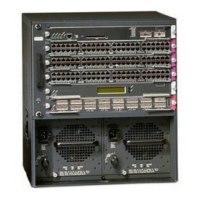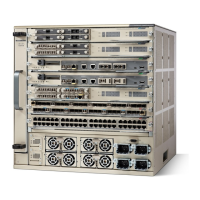8-5
Catalyst 6500 Series Switch and Cisco 7600 Series Router Firewall Services Module Configuration Guide
OL-6392-01
Chapter 8 Configuring IP Addresses, Routing, and DHCP
Configuring OSPF
The advantages of OSPF over RIP include the following:
• OSPF link-state database updates are sent less frequently than RIP updates, and the link-state
database is updated instantly rather than gradually as stale information is timed out.
• Routing decisions are based on cost, which is an indication of the overhead required to send packets
across a certain interface. The FWSM calculates the cost of an interface based on link bandwidth
rather than the number of hops to the destination. The cost can be configured to specify preferred
paths.
The disadvantage of shortest path first algorithms is that they require a lot of CPU cycles and memory.
The FWSM can run two processes of OSPF protocol simultaneously, on different sets of interfaces. You
might want to run two processes if you have interfaces that use the same IP addresses (NAT allows these
interfaces to coexist, but OSPF does not allow overlapping addresses). Or you might want to run one
process on the inside, and another on the outside, and redistribute a subset of routes between the two
processes. Similarly, you might need to segregate private addresses from public addresses.
Redistribution between the two OSPF processes is supported. Static and connected routes configured on
OSPF-enabled interfaces on the FWSM can also be redistributed into the OSPF process. You cannot
enable RIP on any of the same interfaces as the interfaces on which OSPF is enabled. Redistribution
between RIP and OSPF is not supported.
The FWSM supports the following OSPF features:
• Support of intra-area, interarea, and external (type I and Type II) routes.
• Support of a virtual link.
• OSPF link-state advertisement (LSA) flooding.
• Authentication to OSPF packets (both password and MD5 authentication).
• Support for configuring the FWSM as a designated router or a designated backup router. The FWSM
also can be set up as an area border router; however, the ability to configure the FWSM as an
autonomous system boundary router is limited to default information only (for example, injecting a
default route).
• Support for stub areas and not-so-stubby-area (NSSA).
• Area boundary router type-3 LSA filtering.
• Advertisement of static and global address translations.
Enabling OSPF
Single context mode only
Routed firewall mode only
To enable OSPF, you need to create an OSPF routing process, specify the range of IP addresses
associated with the routing process, then assign area IDs associated with that range of IP addresses.
To enable OSPF, follow these steps:
Step 1 To create an OSPF routing process, enter the following command:
FWSM(config)# router ospf
process_id
This command enters the router configuration mode for this OSPF process.
The process_id is an internally used identifier for this routing process. It can be any positive integer. This
ID does not have to match the ID on any other device; it is for internal use only. You can use a maximum
of two processes.
